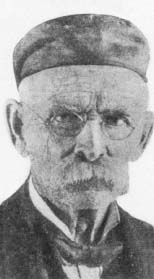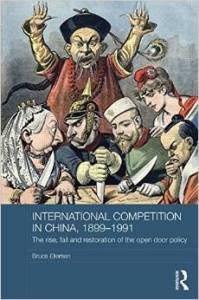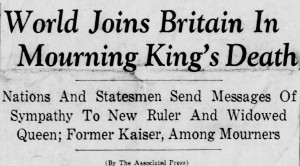Posted: June 1st, 2015 | No Comments »
Photographer Nicholas Kitto has spent the last seven years visiting all the larger former Treaty Ports to photograph the remaining buildings from that era. At the same time he’s been seeking to track down the homes and offices of various members of his family who were in China from the 1860’s until 1945.
He has generously made all these photos available at his Treaty Port Galleries website – here – well worth a browse…

Posted: May 31st, 2015 | No Comments »
Selina Lai-Henderson’s Mark Twain in China sheds light on Twain’s interest in China and that country’s interest in him….

Mark Twain (Samuel Langhorne Clemens, 1835-1910) has had an intriguing relationship with China that is not as widely known as it should be. Although he never visited the country, he played a significant role in speaking for the Chinese people both at home and abroad. After his death, his Chinese adventures did not come to an end, for his body of works continued to travel through China in translation throughout the twentieth century. Were Twain alive today, he would be elated to know that he is widely studied and admired there, and that “Adventures of Huckleberry Finn” alone has gone through no less than ninety different Chinese translations, traversing China, Taiwan, and Hong Kong. Looking at Twain in various Chinese contexts–his response to events involving the American Chinese community and to the Chinese across the Pacific, his posthumous journey through translation, and China’s reception of the author and his work, “Mark Twain in China” points to the repercussions of Twain in a global theater. It highlights the cultural specificity of concepts such as “race,” “nation,” and “empire,” and helps us rethink their alternative legacies in countries with dramatically different racial and cultural dynamics from the United States.
Posted: May 30th, 2015 | No Comments »
I first came across early American photojournalist James Ricalton’s (below looking like a fascinating chap) stereoscopes of China while researching my history of foreign correspondents in China, Through the Looking Glass (yes, Metropolitan Museum of Art – I already did that title!). Here though is an essay – China Through the Stereoscope – on Ricalton’s stereoscopes by Lissa Mitchell (I think there’s meant to be two S’s?) in New Zealand’s Off the Wall from 2014 (that I somehow missed when it first appeared). Well worth a look and a read.

Posted: May 30th, 2015 | No Comments »
China & ANU — Diplomats, Adventurers, Scholars
Exhibition dates: Friday, 29 May – Friday, 18 September 2015, and selected weekends
Gallery hours: 9:00am – 5:00pm, Monday to Friday

The Pacific War and its aftermath radically transformed Australian perceptions of what was then called ‘the Near North’ (Asia). Many recognised that in the postwar world Australia’s strategic interests and economic fortunes called for a new understanding of Asia and the Pacific. China loomed large in these calculations.
Australia’s first diplomatic representative to the Republic of China, Frederic Eggleston, was posted to the wartime capital of Chungking in 1941. In his despatches to Canberra he urged the government to recognise the importance of Asia and the Pacific in preparation for China’s emergence as a major power following the Pacific War. When Eggleston joined the Interim Council of The Australian National University (ANU) in 1946, he promoted the study of China as a key feature of the new School of Pacific Studies — today’s College of Asia and the Pacific.
In 1947, Eggleston wrote to Australia’s second minister to China, the noted economist Douglas Copland, to see if he would be interested in becoming the inaugural Vice-Chancellor of the new university. Copland accepted the position and, in 1948, he returned from a China embroiled in civil war to oversee the founding of ANU. It was on Copland’s recommendation that the British writer and scholar CP FitzGerald — whom he had known in postwar Nanking — was appointed as the university’s first China scholar. With Copland’s support, FitzGerald travelled to Hong Kong and acquired the library of the renowned writer and Buddhist scholar, Hsu Ti-shan 許地山. These books form the core of the Menzies Library Chinese collection, which has played a pivotal role in the scholarly study of China in this country.
Based on extensive research and featuring rare archival documents, photographs and films ‘China & ANU’ introduces the diplomats, adventurers and scholars who contributed to Australia’s engagement with China, the ‘Chinese Commonwealth’ and our region. In particular, the exhibition focusses on the interconnection between Australia’s first diplomat-scholars in China and Chinese Studies at the newly established Australian National University.
Special Events
Building Tour & Chinese Tea
Thursday, 23 April
5:15 – 5:45pm, The Bamboo Hall
Join us for a tour of the award-winning China in the World Building, designed by the Beijing-based architect Gerald Szeto å¸å¾’ä½. A selection of Chinese tea will be served in the CIW Teahouse following the tour.
Public Lecture: China & ANU – Diplomats, Adventurers, Scholars
Thursday, 23 April
6:00 – 7:00pm, The Auditorium
As part of the 2015 Canberra and Region Heritage Festival, titled ‘Conflict and Compassion’ to mark this ANZAC centenary year, CIW research scholar William Sima will discuss the connection between Australia’s first diplomatic representatives to the Republic of China and the establishment of Chinese Studies at The Australian National University.
Posted: May 29th, 2015 | No Comments »
Every so often the Chinese press likes to print pictures of mass marriage ceremonies in one famous spot or another. Usually it’s due to an auspicious day. The tradition was of course popular in the Cultural Revolution and the Maoist period but predates that. Here, in 1936, a mass marriage ceremony of over 100 couples in Shanghai – apologies but I can’t verify the location. Note that the grooms are all in traditional dress while the brides are almost all in European style wedding gowns. It was a civil ceremony presided over the Mayor of Shanghai, General Wu Te-chen.

Posted: May 28th, 2015 | No Comments »
A much needed and fascinating reappraisal and consideration of the Open Door Policy from Bruce Elleman….

China’s recent economic reforms have opened its economy to the world. This policy, however, is not new: in the late nineteenth century, the United States put forward the Open Door Policy as a counter to European exclusive ‘spheres of influence’ in China. This book, based on extensive original archival research, examines and re-evaluates China’s Open Door Policy. It considers the policy from its inception in 1899 right through to the post-1978 reforms. It relates these changes to the various shifts in China’s international relations, discusses how decades of foreign invasion, civil war and revolution followed the destruction of the policy in the 1920s, and considers how the policy, when applied in Taiwan after 1949, and by Deng Xiaoping in mainland China after 1978, was instrumental in bringing about, respectively, Taiwan’s ‘economic miracle’ and mainland China’s recent economic boom. The book argues that, although the policy was characterised as United States ‘economic imperialism’ during the Cold War, in reality it helped China retain its sovereignty and territorial integrity.
Posted: May 27th, 2015 | No Comments »
Alexa Raymond’s Jungle Jim cartoon strip was popular in the 1930s, starting in 1934, chronicling the adventures of Far East-based hunter Jim Bradley. Not long after launching the strip Raymond introduced Lilli de Vrille, better known as Shanghai Lil…..bet you’d like to see her – here in 1935??


Posted: May 26th, 2015 | No Comments »
Shanghai before the war was of course a city famed for 24/7, 365 partying and nightlife. Nothing interrupted it – not war, civil strife, plague outbreaks, freezing cold or stinking humidity – except, it seems, the death of King George V in January 1936. So significant was this that the papers at the time felt it important to record that the city’s nightlife halted for a moment. Of course, as a footnote, George V’s death meant the accession to the throne of Edward VIII who had to abdicate after a short stint due to a certain American lady with a rather shady Shanghai past!!











